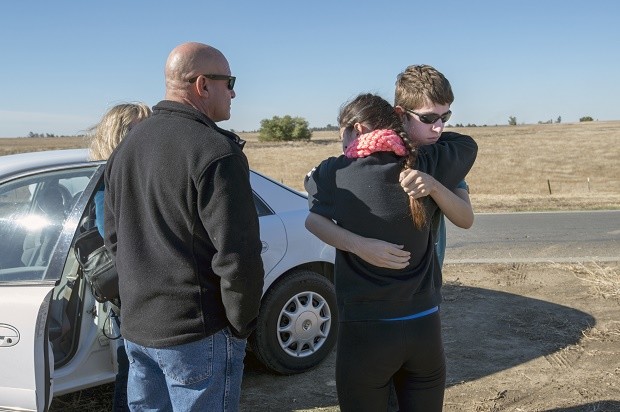Experts: IS expanding its global reach through social media

In this Wednesday, Nov. 4, 2015, file photo, University of California, Merced student Justin Dick, right, hugs his sister Kristen as his parents Beth and Keith look on following a stabbing in Merced, Calif. An assailant stabbed five people at the rural university campus in central California before police shot and killed him, authorities said Wednesday. Justin was one of 15 students in the core class where the incident took place Wednesday morning. A California university student who went on a campus stabbing rampage that wounded four people before he was shot down by a campus police officer was inspired by Islamic State but acted alone, the FBI said Thursday, March 17, 2016. PAUL KITAGAKI JR./THE SACRAMENTO BEE VIA AP FILE PHOTO
FRESNO, California — Law enforcement officials believe the San Bernardino massacre and a stabbing attack on a California college campus were done by lone wolves inspired by the Islamic State group, and counterterrorism experts say both show how the organization is expanding its reach through social media.
Recruitment videos the extremists post online are often short and flashy. They feature hip-hop music, promising a chance to be part of a global cause and, experts say, most importantly target to a vulnerable audience.
“For somebody searching for meaning and feeling disconnected, that’s a very powerful message, and difficult to resist,” said John Cohen, a criminal justice professor at Rutgers University and formerly the Department of Homeland Security’s counter terrorism coordinator.
READ: Social media, the new megaphone for violent perpetrators
That’s how Faisal Mohammad, an 18-year-old freshman at the University of California, Merced, appears to have become self-radicalized. The FBI says he visited IS websites for several weeks before he wounded four people in the Nov. 4 knife attack. A campus police officer shot and killed him.
A month later, the gun-wielding husband-and-wife team in San Bernardino shot and killed 14 people and wounded 21 others. Investigators say they were also influenced by the Islamic State group, but not directly connected to it.
“The Internet enables people who aren’t necessarily able to function well in a group to claim at least that they’re inspired by an ideology,” said Jessica Stern, a research professor at the Pardee School for Global Studies at Boston University.
Mohammad had been shunned by a study group at U.C. Merced, where he was a freshman, authorities have said, and Syed Rizwan Farook, 28, launched the San Bernardino attack with his wife against a group of colleagues gathered at a luncheon.
“More must be done to combat jihadists’ narrative and their use of the Internet to radicalize, recruit, and fundraise,” said Majority Leader Kevin McCarthy, a Republican from Bakersfield. He cited two dozen IS-inspired plots in the United States since 2014.
Lone-wolf attacks carried out in this country are a “Western luxury,” said Max Abrahms, a political science professor at Northeastern University. He says it’s a sign that there are not large terrorists groups carrying out attacks.
READ: Profiles of radicals reveal numerous paths to extremism
But he agrees that isolated attacks are likely to increase as the Islamic State is increasingly under fire in its strongholds in Iraq and Syria.
“Islamic State is going to continue to decentralize as it gets battered,” Abrahms said. “The Internet isn’t going away. The group is going to call upon locals to commit attacks.”
READ: 4 stabbed, attacker killed at central California university














